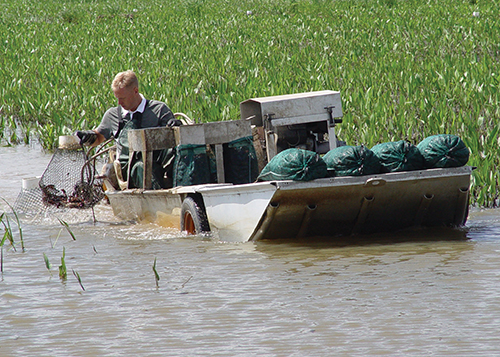
Ailing Industry: No Good News for Shrimp
June 13, 2018
Crawfish Recovers From Cold, Season Saved by Warm Spring
June 13, 2018Written in partnership with the Houma-Terrebonne Airport Commission
Our area’s economy goes as the oil and gas industry goes – that’s no secret.
When the price of oil is high, work is abundant locally, which lowers unemployment, lifts sales tax figures and creates a situation which is beneficial to everyone. But when the price sinks, the opposite takes fold and everyone suffers.
It’s a helpless feeling for many because no one locally can impact the price, so as it rises and falls, locals are sort of left in limbo wondering about what might happen next. But change may be on the way to the local economy which could ease some of that anxiety for future generations, while diversifying the economy enough to keep our area strong in all economic situations.
The Houma-Terrebonne Airport has dedicated years of research into studying the local employment of large unmanned aircraft systems (L-UAS) – an advancement which experts say could create hundreds of jobs locally, while generating millions in annual revenue.
George Rey, of COTS Technology, is consulting the airport on the project. He said that when it’s complete, it will be a game-changer for the bayou area. The airport aims to create the “UAS Gulf of Mexico Center of Excellence” with its work, while partnering with Nicholls and Fletcher to train students to become future workers. A study conducted by TEDA conservatively estimate 1,600 jobs to come into the area, as well as more than $1.2 billion in economic impact.
The Houma Airport has been studying this idea over the past several leadership regimes, but it’s now on its way to completion.
“The employment of L-UAS’s at the Houma-Terrebonne Airport will significantly improve flight safety, develop new L-UAS FAA standards and improve economic prosperity throughout the transportation sector on a local, regional and global scale,” Rey said. “The ‘UAS Gulf of Mexico Center of Excellence’ provides the path forward to new technology and economic growth in Louisiana.”
The local plan is replication of work currently being done in North Dakota. Investors there are using a vast open area in the northern plains to conduct L-UAS flight operations.
“The state has invested $17 million of public monies into infrastructure at Grand Sky Technology Park,” Rey said.
The idea is to employ local unmanned aircraft to service the oil and gas industry. Once complete, the helicopters will haul tools, supplies and other logistical needs to rigs.
The airport said work will start servicing oil and gas, but opportunities for expansion to other industries exist and, once completed, the area can also use its brain trust to train other communities who want to make the same push.
Joe Wheeler, Executive Director of the Houma-Terrebonne Airport Commission, concedes that pilots will lose some work in the project, Wheeler concedes, but other job creation far outweighs the one downfall.
“You’re still always going to have to have a licensed pilot monitoring systems to make sure things are going well,” Wheeler said. “And for every aircraft you have that flies offshore, you have four maintenance positions and other positions to make sure the helicopter is able to operate and with unmanned crafts, you can multiply that times two. The workforce will grow immensely.”
Wheeler, Rey and officials with Nicholls and Fletcher toured the North Dakota site this past winter to study the development of the project and also to understand how economic development tied into the project.
Rey said the meeting was a success and Wheeler added he and the team left with great confidence that this will benefit our area.
“It was incredible,” he said.
So now, the airport is focused on continued progression.
Wheeler said several major companies are supporting the project, including a tie with Boeing Aircraft, as well as several other local aviation powers.
“It’s very exciting for us,” Wheeler said. “The support is incredible.”
Wheeler concedes that the process will not impact the area quickly, but over time, it will prove well worth the investment.
“The impacts are pretty significant,” Wheeler said. “It’s not within the first five years, but once we get with Nicholls and Fletcher to get these people trained up, it will be a huge aid. These are good jobs – long-term jobs, career jobs. You’re looking at $60,000 to $90,000 per year depending on the tech job and there, of course, is advancement within the positions.
“But while we’re focused on the oilfield, we also know that what we’re doing can be transferred worldwide. As far as we know, no one else in the U.S. is trying to do this. We want to be the people that the FAA says, ‘Hey, these folks in Houma are doing this, go talk to them,’ when others try and replicate this technology. We’re not reinventing the wheel. We’re just trying to mold it and make it work for our area.” •









